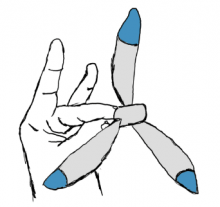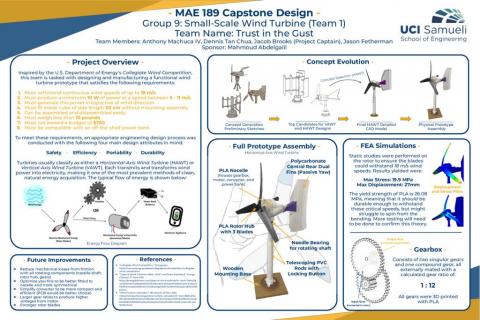Small-Scale Wind Turbine Prototype
Background
Wind turbines accomplish a much cleaner, environmentally-friendly method of generating electricity than fossil-fuel alternatives. It is one of many ways we can exploit Earth's natural processes in a benign manner by harnessing the kinetic energy contained within movements of air across the planet's surface. Each turbine functions as one large energy transfer between wind power and electrical power through various internal processes housed within the structure itself. This kinetic wind energy must first be transformed into rotational mechanical energy through the turbine's large set of aerodynamic rotor blades. This rotor in turn will rotate an internal shaft that must connect to the motor of the turbine, either directly or through a system of gears and belts. The motor's sole purpose to translate this mechanical energy into electrical energy, which then can be circuited to a power bank where it can be stored and used later for various applications, similar to batteries. A wind turbine's efficiency can often be measured by how well the motor can generate power in a range of rotor speeds, which comes down to optimal motor choice, blade aerodynamics, gear ratios, weight, size, and control systems. Despite how simple its function may seem, the design it requires is much more complicated and forces engineers to think critically about the best ways of designing for efficiency.
Goals and Objectives
This project will conclude with a functioning prototype accompanied by a testing plan for verification and a detailed technical design report. Along with being functional, this wind turbine should meet all requirements with a large focus on design safety, efficiency, durability, and portability. A strict adherence to the engineering design process will be upheld, requiring that the project allocate sufficient time for background research, concept generation and selection, market research, detailed designs, and manufacturing of a final deliverable design. These key stages/milestones of the project are summarized below along with expected times of completion:
- Weeks 1-2: Team Organization & Background Research
- Week 3: Concept Generation and Comparative Analysis
- Week 4: Concept Selection (Preliminary Design) and Market Research
- Week 5: Detailed Design w/ CAD Models and Circuit Schematics
- Weeks 6-8: Manufacturing of Prototype & Sub-Assembly Testing
- Weeks 9-10: Full Prototype Assembly with Testing Plan and Technical Design Report
Wind Turbine System Requirements
This quarter's project prototype must satisfy the following requirements derived from the Collegiate Wind Competition in no particular order:
- Must withstand continuous speeds of up to 18 m/s
- Must produce minimum power output of 10 Watts at at least one speed between 5 - 11 m/s
- Must be capable of generating power irrespective of wind direction
- Must fit within cube of side length 50 cm without mounting assembly
- Can be assembled and disassembled easily
- Must not weight more than 10 pounds
- Project budget must not exceed $750
- Must be compatible with off-the-shelf power bank energy storage device
Midterm Status Report Presentation Slides
Final Status Report Presentation Slides
Team Contacts
Jacob Brooks | jacobcb@uci.edu
Jason Fetherman | jfetherm@uci.edu
Dennis Chua | dtchua@uci.edu
Anthony Machuca | aimachu1@uci.edu
Sponsor/Advisor
Mahmoud Abdelgalil | maabdelg@uci.edu


